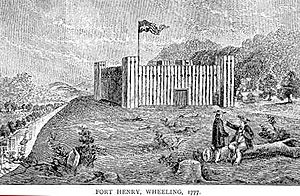Siege of Fort Henry (1777) facts for kids
Quick facts for kids First siege of Fort Henry |
|||||||
|---|---|---|---|---|---|---|---|
| Part of the American Revolutionary War | |||||||
 Sketch of Ft Henry |
|||||||
|
|||||||
| Belligerents | |||||||
Virginia State Forces Virginia settlers |
Native Americans White Loyalists |
||||||
| Commanders and leaders | |||||||
| David Shepherd Joseph Ogle Samuel Mason |
Pomoacan | ||||||
| Strength | |||||||
| 3 companies of militia settlers |
200 Native Americans: Wyandot Mingo Shawnee Delaware |
||||||
| Casualties and losses | |||||||
| 15 killed 5 wounded |
1 killed 9 wounded |
||||||
The First Siege of Fort Henry was an attack by Native American warriors on American citizen-soldiers during the American Revolutionary War. This event happened in September 1777 near Fort Henry, an outpost in Virginia. Fort Henry was named after Virginia's Governor, Patrick Henry. At first, only a small number of defenders were at the fort. Many other citizen-soldiers had left because rumors of the attack spread faster than the attackers. However, the American settlers successfully fought off the Native American attack.
Contents
Why the Attack Happened: Background
In the summer of 1777, people living on the edge of the American frontier heard rumors. These rumors said that Native American groups in the Ohio Country were planning attacks. They aimed to strike settlements along the Ohio River. Fort Henry, built in 1774, was one of the places they were rumored to attack. This fort was made to protect settlers near what is now Wheeling, West Virginia.
In early August, General Edward Hand warned the local leaders. He was the commander at nearby Fort Pitt. He told Lieutenant David Shepherd and other local citizen-soldier captains about the danger. He ordered them to gather at Fort Henry. For a while, many citizen-soldier groups stayed at the fort. They made its defenses stronger and looked for any signs of attack. But when no immediate threat appeared, many groups went back home. By the end of August, only two groups remained. These were led by Captains Joseph Ogle and Samuel Mason.
The Battle at Fort Henry
The exact date of the battle is unclear. Some records say it was September 1, while others say September 21.
Native American Approach and First Shots
On the night of the battle, about 200 Native American warriors quietly approached the fort. Most of them were Wyandot and Mingo warriors. There were also some Shawnee and Delaware warriors. Their leader was the Wendat chief Pomoacan.
Early that morning, four men left the fort. The Native American warriors attacked them, killing one. The other three escaped. Two of them ran back to the fort to warn everyone.
Ambushes and Retreats
The Native American warriors expected the fort's defenders to come out. So, they set up an ambush. Captain Mason led a group of men out to find the warriors. They almost walked right into the trap. One of Mason's men, Thomas Glen, saw a warrior and shot him. This caused the Native American warriors to start firing.
Mason and his men saw they were almost surrounded. They had to retreat. Mason was badly hurt and had to hide by the path. He could not make it back to the fort right away. When Captain Ogle led another group out to help, his group was also attacked. He had to find cover too. Eventually, both Mason and Ogle managed to get back inside the fort.
Major McColloch's Brave Leap
After these events, the Native American force burned the cabins around the fort. They also destroyed livestock. Major Samuel McColloch led a small group of men from Fort Vanmetre. They traveled along Short Creek to help Fort Henry. McColloch got separated from his men. Native American warriors chased him.
On his horse, McColloch rode up Wheeling Hill. Then he made a famous jump, known as McColloch's Leap. He rode his horse 300 feet (about 91 meters) down the eastern side of the hill to safety. The warriors rushed to the edge, expecting to see him dead at the bottom. To their surprise, they saw McColloch still on his white horse, galloping away.
After the Fight
The Native American warriors stayed outside the fort overnight. They danced and made noise, but they did not attack the fort directly. They left the next morning. They had one warrior killed and nine wounded. The Americans lost fifteen men, with five wounded.

